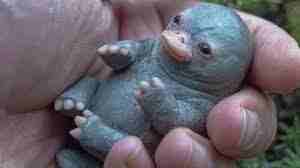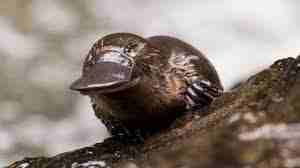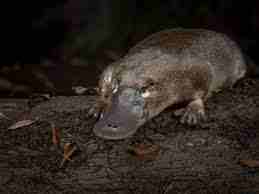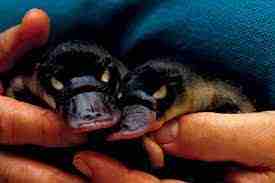The baby platypus is undoubtedly an incredibly unique creature that captures the imagination of anyone who lays their eyes on it. With its delicate constitution and a combination of characteristics from numerous animal species, it’s no surprise that this tiny bug attracts attention from people of all ages.
Table of Contents
What is surprising, however, is that this adorable little creature was initially thought to be a joke – with scientists assuming it was merely organs from different animals grouped together. Nevertheless, as more and more of these enchanting creatures were discovered, people quickly began to fall in love with them.
In this article, we will explore the various distinctive traits of the baby platypus that make it so captivating and why it is currently enjoying such widespread attention.
Platypus (Ornithorhynchus anatinus)

Before delving into the baby platypus, let’s first gain a concise comprehension of the platypus.
Scientific Classification
Here is the scientific categorization of the platypus:
Kingdom:
The platypus belongs to the Animalia kingdom.
Phylum:
It is categorized under the Chordata phylum.
Class:
Platypuses are enlisted in the Mammalia class due to their young feeding on their mother’s milk.
Order:
Because the platypus lays eggs, it is included in the Monotremata order.
Family:
The platypus’ family is known as Ornithorhynchidae.
Genus:
The genus of the platypus is Ornithorhynchus.
Species:
The scientific name for the platypus is O. anatinus.
Electrolocation
The platypus falls under the category of monotremes, making it the sole mammal possessing electroreception. This unique ability allows them to detect prey by sensing electric fields generated by muscular contractions. Among all monotremes, the platypus displays the most sensitive electroreception, with their bill skin containing prominent electroreceptors in the rostrocaudal rows.
Biofluorescence
In 2020, a study on biofluorescence revealed that when exposed to black light, the platypus emits a bluish-green glow.
Reproduction
The question of whether the platypus lays eggs was resolved in 1884 when William Hay Caldwell’s team confirmed that it is indeed a mammal that lays eggs.
Evolution
Fossil evidence and the molecular clock suggest that platypuses diverged from echidnas around 19 to 48 million years ago. The oldest known fossil of the modern platypus dates back 100,000 years to the quaternary period, and various fossil records indicate their presence in different regions across multiple eras.
Platypus Habits
The platypus has been used by humans as a source of food and has cultural significance as well.
Baby Platypus
Regarding their habits, platypuses prefer solitary living but often share their aquatic habitat with other members of their species. They spend a majority of their time in water searching for food and the rest in burrows or basking in the sun.
Other Names Of Baby Platypus
Baby platypuses have often been likened to chimeras due to their unique combination of features, including a beaver-like tail, duck-like bill, reptile-like stingers, otter-like fur, webbed feet, and sharp claws.
The baby platypus is commonly referred to as a “puggle,” a term also used for the young of echidnas, another Australian mammal. There have been discussions about potentially changing the name to “platypup,” but no confirmed decisions have been made yet.
Weight Of Normal Baby Platypus
When born, a puggle platypus weighs only about 50 to 80 grams and is incredibly delicate and tiny, about the size of a nickel. They rely entirely on their mother’s care for about three to four months and cannot swim at this stage.

Size Of Puggle Platypus
The baby platypus measures around 3 cm at birth, making them dependent on their mothers for significant care. They reach sexual maturity and full size by the age of 18 months.
Baby Platypus Habitat
Puggle platypuses live in tunnels dug by their mothers, where they hatch from eggs. After a few months, they begin attempting to swim and spend some time in the water. Baby platypuses are mainly found near Tasmania and eastern Australia, hiding during the day and foraging for food at night, occasionally being active during the day.
Platypus Babies Food
As mammals, platypuses feed their young with milk. However, the mother platypus lacks teats. Instead, she sweats out the milk, which pools into grooves for the baby platypus to drink. They also suck milk from the mother’s hair. As they grow, the diet of platypus young changes, with nursery-age platypuses consuming insects and juvenile platypuses eating shrimp, crayfish, and other small fish. As adults, they feed on dragonflies, water beetles, and other aquatic invertebrates.
Interesting Facts About Baby Platypus

Here are some fascinating facts about the adorable baby platypus:
#1 – Toothed Hatchlings:
Baby platypuses, like other egg-laying creatures, are born with temporary teeth known as egg teeth. These teeth help them break out of their eggshells and begin their new life. However, by the time they reach four months old, they lose these teeth and do not grow them back. As adults, they lack teeth altogether and use small rocks or gravel to aid in chewing their food.
#2 – Venomous Male Puggles:
One intriguing fact about male baby platypuses, known as “puggles,” is that they are venomous. They have a stinger on their hind legs that secretes venom. Initially believed to be for self-defence, it was later observed that male puggles produce venom during the mating season, possibly playing a role in their reproductive behaviour. Remarkably, only 16 mammals worldwide possess venom.
#3 – Egg-Hatching Mammals:
Baby platypuses are unique among mammals as they hatch from eggs. As members of the monotremes group, they exhibit characteristics different from typical mammals. Despite having a lower body temperature than most mammals, they remain warm-blooded creatures.
#4 – Initial Inability to Swim:
Baby platypuses are unable to swim right after birth. It is only when they mature, around nine months old, that they start swimming to find food. During this period, they learn essential swimming and survival skills from their mother, who teaches them how to manoeuvre, use their webbed feet and tail together for speed, and navigate through water.

#5 – Hairless Hatchlings:
When baby platypuses hatch from their eggs, they are initially hairless. After about four months, they develop a complete coat of fur that provides protection and allows them to spend hours in the water without getting wet. Interestingly, their fur glows under UV blacklight.
#6 – Absence of a Stomach:
Surprisingly, platypus babies, known as “platypus,” are born without a stomach. Their simple diet doesn’t require extensive digestion, so whatever they eat moves directly to their intestines. The reason for this absence of a stomach in platypus babies is not fully understood and remains a subject of ongoing research.
Frequently Asked Questions about Baby Platypuses:
#1 – What is a baby platypus called?
Baby platypuses are commonly known as “puggles,” but there is an ongoing possibility that their name may change to “platypups.” However, no official announcement has been made regarding this change.
#2 – How venomous is a baby platypus?
While baby platypuses are among the rare venomous mammals, it’s essential to note that only the male baby platypus (puggle) is venomous, not the female. The venom of the male baby platypus can cause excruciating pain, similar to being stung by hundreds of hornets.
#3 – Are platypuses friendly?
Platypuses are generally shy creatures and do not pose a threat to humans. They do not attack humans, and since they lack teeth, there is no danger of biting.
#4 – Can you keep a baby platypus as a pet?
As much as many people would love to have a baby platypus as a pet, it is important to consider that male platypuses are venomous, which can cause severe harm. Additionally, it is illegal to own a platypus as a pet in Australia, and exporting baby platypuses is also prohibited.
#5 – Is the platypus born alive?
No, the platypus is not born alive. Instead, they belong to the category of mammals that hatch from eggs, making them monotremes.
#6 – Is the platypus blind?
The platypus is not blind, but their eyes are positioned above their bills, making it challenging to see below them. While swimming, the platypus has skin flaps that cover their ears and eyes underwater, temporarily limiting their vision. However, they use their bills underwater to locate food efficiently.

Final Words
The baby platypus is truly a creature like no other. It breaks all the rules of what we typically expect in the animal kingdom. This little mammal is hatched from an egg, which is unexpected, to say the least. And unlike other mammals, the mother doesn’t feed the baby through teats. Rather, the milk is sucked from the mother’s body grooves by the platypus.
These little creatures are always fascinating to observe, especially given their strange appearance. With otter-like feet, duck-like beaks, and beaver-like tails, they truly are a unique species. And let’s not forget those tiny teeth that help them break free from their eggshells once the incubation period is complete. Overall, baby platypuses, or puggles as they’re sometimes called, are a fantastic and rare sight to behold.
Reference:
- https://www.australiangeographic.com.au/topics/wildlife/2021/06/thats-not-a-baby-platypus-this-is-a-baby-platypus/
- https://www.britannica.com/animal/platypus/Life-cycle-and-reproduction
- https://www.nationalgeographic.com/animals/mammals/facts/platypus

Rahul M Suresh
Visiting the Zoo can be an exciting and educational experience for all involved. As a guide, I have the privilege of helping students and visitors alike to appreciate these animals in their natural habitat as well as introducing them to the various aspects of zoo life. I provide detailed information about the individual animals and their habitats, giving visitors an opportunity to understand each one more fully and appreciate them in a more intimate way.









